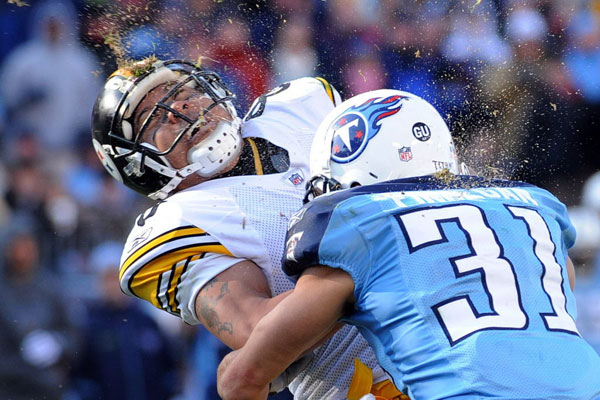Smashed Him Bro!
Admittedly the research studied American athletes who play sports like ice hockey and American football, in which mandatory protective clothing and helmets allow players to use their bodies and heads as weapons. Ironically, this actually increases the risk of head injury. But the underlying problems hit a little closer to home. If you play rugby or league, at some point you are going to take a clonk to the head, risking concussion and brain injury.
I'm going to let you in on a little secret. During several rugby games I have sustained what was almost certainly a concussion, but played on. Short-term memory loss, blurred vision, a massive headache after the game – check, check, and check. On one occasion I completely forgot all the backline moves, the score, and who the opposition were, but finished the game anyway. It finally dawned on me that concussion wasn’t a joke after I ended up in hospital for a few days after getting knocked into next week. I still can't remember how it happened.
The Sunday programme focussed on 10-test All Black Steve Devine. Devine had to retire early after being knocked out so many times he started suffering from chronic fatigue and constant migraines. The presenters also talked to a teenager in Australia whose parents were threatening to ban him from playing league if he got another head knock. Possibly a wise move – studies revealed that as few as eight “concussive episodes” before the age of 22 can have serious and irreversible effects.
So what needs to happen to stop everyone who picks up a rugby ball from becoming a drooling vegetable? There is no way kids are going to stop play contact sports – they’re far too much fun – but there is no easy way to prevent head knocks in these sports. Contact sport is here to stay, but our attitude towards head injuries needs to change.
Too often we see professional rugby players get laid out on the ground after a massive head knock, stumble around a bit, get a drink of water from the physio, then carry on. Steve Devine's ongoing problems seem to stem from his All Black debut. He was dazed after being hit in the head by a knee early in the game, but played on. He then got a second blow to the head, which finished him off. When kids see their heroes playing through head injuries they think they are being brave. What they need to think is that they are being stupid.
The sports world is slowly waking up to the new reality. In the USA, 1500 ex-NFL players filed a lawsuit against the NFL, claiming they were not made aware of the risks of the brain injuries they were suffering. The NFL has subsequently started to discourage the use of the head/helmet as a weapon used to cripple the opposition. The NRL says they have always taken concussion seriously, but in the past players with concussion have been allowed to continue far more often than they've been taken off. After Frank Pritchard levelled David Simmons (Youtube it) in Round One this season, the NRL have come down hard on any contact to the head. Any tackle that targets the head or inadvertently makes contact with the head now results in an automatic penalty and/or a suspension. Some of league’s best defenders have had to re-evaluate their tackling technique.
The professional sports world waking up to the seriousness of head injuries is a great start. Hopefully there will be a trickledown effect, making the sports we love safer for all the people who play them, especially kids. If I haven’t convinced you that kids getting head injuries is a big deal, search “Big Football hit – Helmet to Helmet” on Youtube. Make sure you turn the volume right up.




